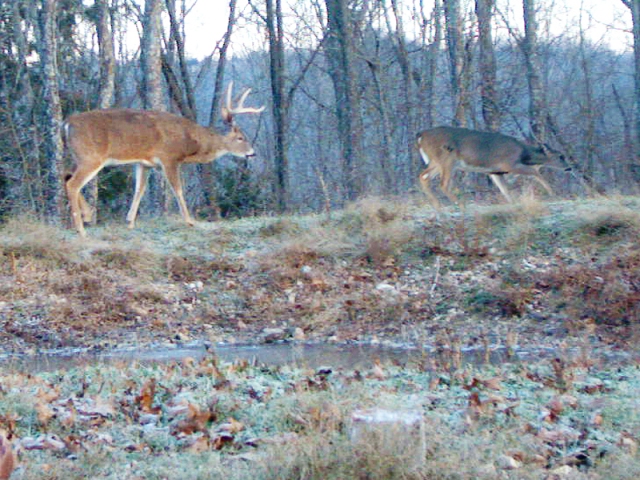Category: Hunting Blog
Managing Whitetails: Habitat Design
This morning I toured a 280 acre tract of land recently purchased by the owners of Redneck Hunting Blinds. The property is in west central Missouri. It’s about 50% tillable land and 50% hardwood forest. A power line and a gas right of way cross the property. Basically the timber is on the west of the property and the crop ground on the east.
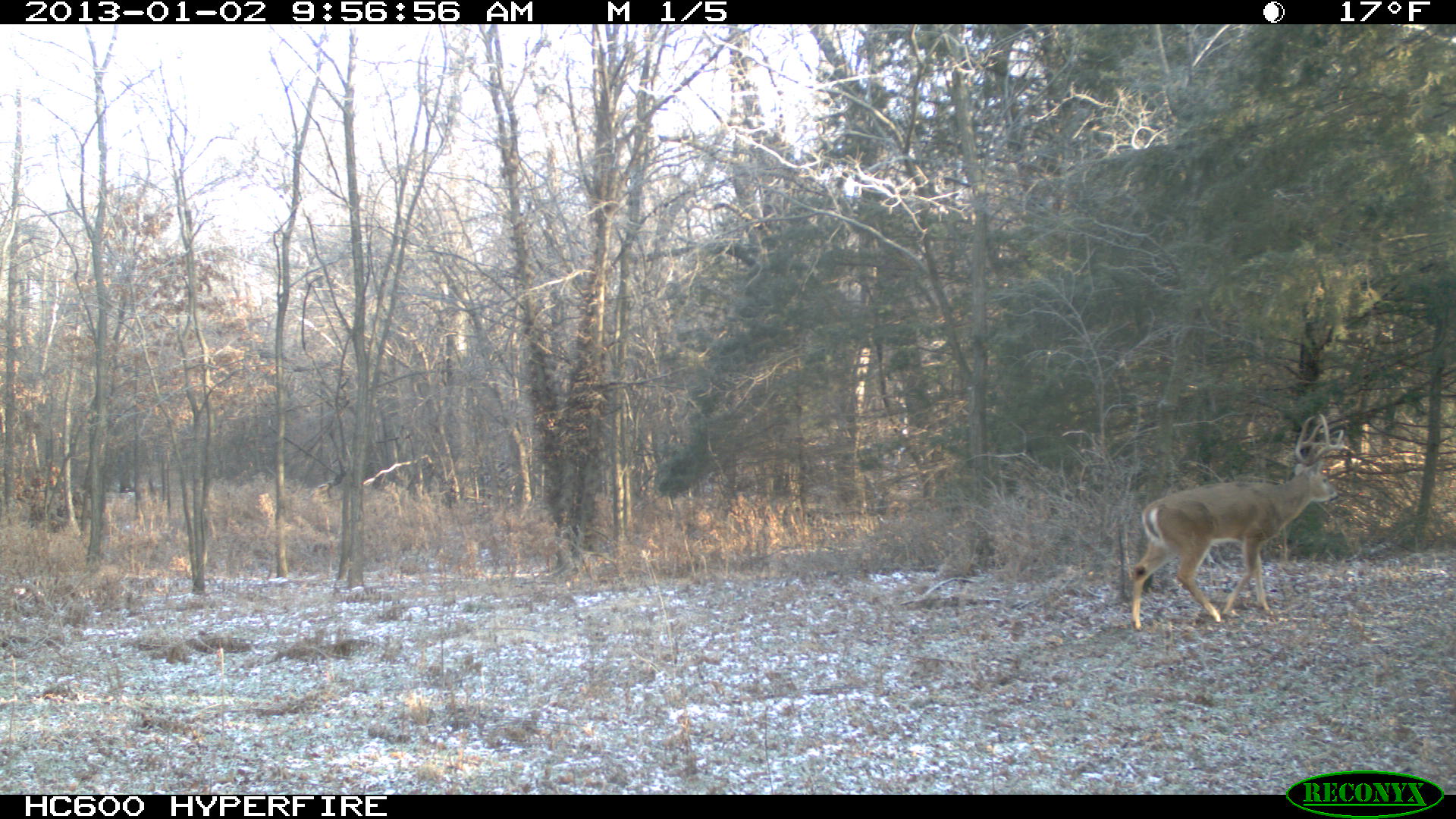
It’s a long way from finding one set of sheds to producing and harvesting two mature bucks annually.
The area has much potential as we found both sheds to the buck in this picture. However, it’s a long way from finding one set of sheds to producing and harvesting two mature bucks annually.
My goal is to design a habitat management and hunting strategy that will yield an average of two mature (4+ year old) bucks to harvest annually – or a mature buck per 100+ acres. That’s a very tall order! However, the habitat is conducive to that objective. I’m not sure about the neighborhood yet.
I always begin by assessing the availability and quality of food, cover, and water. It seems most folks focus on food – either row crop or food plots. However, deer, especially mature bucks, spend the majority of their time during daylight hours in or near cover. This is especially true in areas where row crop ag is the primary land use – especially after the crops are harvested.
The Redneck Proving Grounds has some cover, but no sanctuaries. That’s to say there were no areas where there wasn’t sign (treestands, ATV trails, etc.) of hunting activity. One of my first thoughts during the tour was that I need a plan to encourage mature bucks to spend a majority of their time on the Redneck Proving Grounds. I will accomplish this by creating three sanctuaries in different corners of the properties!
Let me know if you’d like to follow this project closer and I’ll share step by step my plans and the progress.
Growing Deer together,
Grant
Hunting Strategies: Studying Buck Behavior
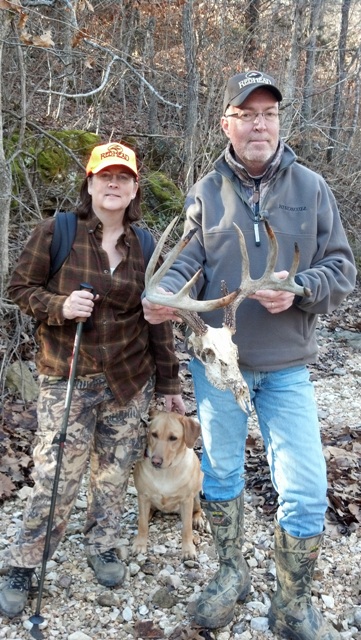
The buck had hard antlers when he died and the skull was totally clean – no tissue left anywhere on the skull.
Deer season is now closed in Missouri. I enjoyed a fun and successful season! However, I must admit that my wife Tracy and her lab, Crystal, have found almost as many inches of antler already this shed hunting season as I tagged during the season.
Yesterday Tracy found a shed from a buck I call Pitchfork. He probably dropped it last year. Pitchfork was a mature buck that I have in hundreds of Reconyx pictures. 90+% of the pictures were taken at night. That’s probably why I’ve never seen Pitchfork even though I’ve hunted him for years.
Based on research data from GPS collars placed on bucks, I’ve learned that each buck has a unique personality. Some seem to follow trends – just like humans, and some are loaners. The toughest to hunt are the loaners that tend to move only during the night. Pitchfork seems to be such a buck. Such bucks are very difficult to pattern and more difficult to hunt. My cameras haven’t taken a picture of Pitchfork in months. I don’t know if he’ll be around next season.
Today Tracy found a skull with a nice typical 10 frame. The top jaw (we couldn’t find the bottom jaw), and antler bases indicate the buck was three or four years old. Estimates based on the top jaw are not as accurate as those based on the bottom jaw. The buck had hard antlers when he died and the skull was totally clean – no tissue left anywhere on the skull. I suspect the buck died last year. I believe this was a buck we called Clover Mountain 10.
Knowing all this, I opted to focus my hunting time on a buck I called The Trashman. I knew from trail camera pictures and my observations that The Trashman tended to be more active during daylight hours than most bucks at The Proving Grounds. These observations proved true as I had several encounters with The Trashman this year and tagged him during late December (watch GDTV 163).
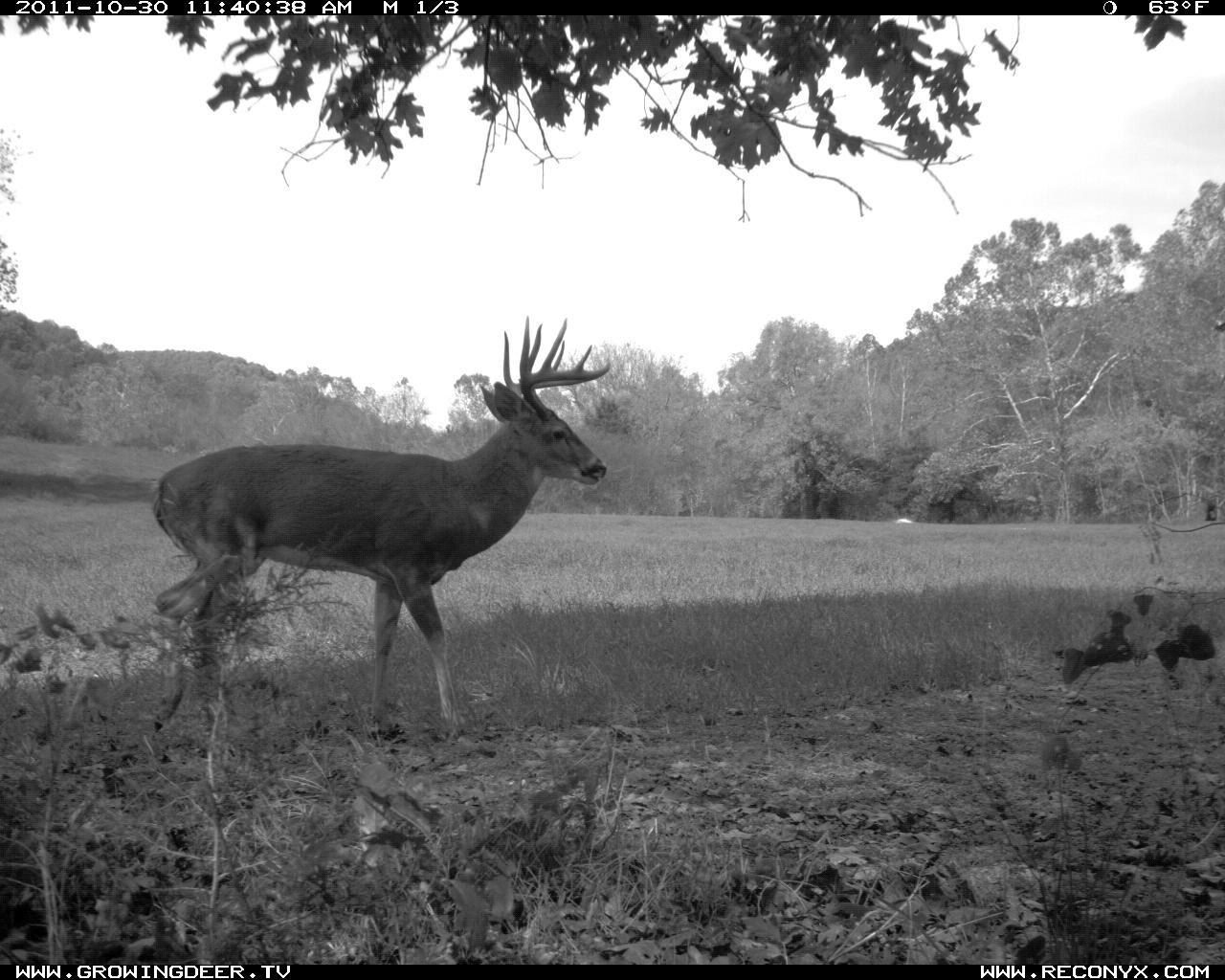
I use trail cameras to study the behavior of bucks. I then decide which bucks I’ll hunt based on their maturity and behavior.
As you begin planning for the next hunting season, don’t forget to use your trail cameras year round. Study the behavior and patterns of the bucks using the property where you hunt. Don’t simply count points and estimate their age. By studying their behavior, you can focus your hunting time on bucks that tend to be more active during daylight hours and increase the odds of tagging a mature buck.
By studying now, you will significantly increase your odds next season.
Growing Deer together,
Grant
The Deer Hunter’s Second Season: Shed Hunting
There are a few more days of archery season in Missouri and a few other states. Grant and the boys still have a few days to fill their tags here at The Proving Grounds. Once archery season ends, Grant will give me permission to start my season – shed hunting! Late winter is the time that I enjoy most here in Missouri. The woods are free of ticks and snakes. The brush has died back so that the hills and glades are easier walking. Best of all – Crystal and I can find special treasures while walking these Ozark Mountains – shed antlers! (Crystal is a Labrador Retriever that I have trained to find and retrieve shed antlers.)
Shed hunting in the Ozarks is not like shed hunting in the states that have flat land like Iowa, Kansas, or Illinois. I envy the folks that can go shed hunting and spot one 300 yards away! Finding a shed in these hills is akin to an Easter egg hunt where the eggs are well hidden. When you find a shed you consider it a special blessing!
My first objective will be to initially walk the valleys in search of deer that may have died during the fall from EHD. Our valley contains a creek that although it isn’t a perennial, flowing source of water, it does have certain deeper holes that held water even through this last summer’s drought. Those are the targets for my initial hunts. Crystal and I will be looking, but not necessarily hoping, to find the bucks that were lost due to the disease. Our fear is that we will find many more like the one Grant recently found pictured below and the one shown in the GrowingDeer.tv video back in September (GDTV 147).
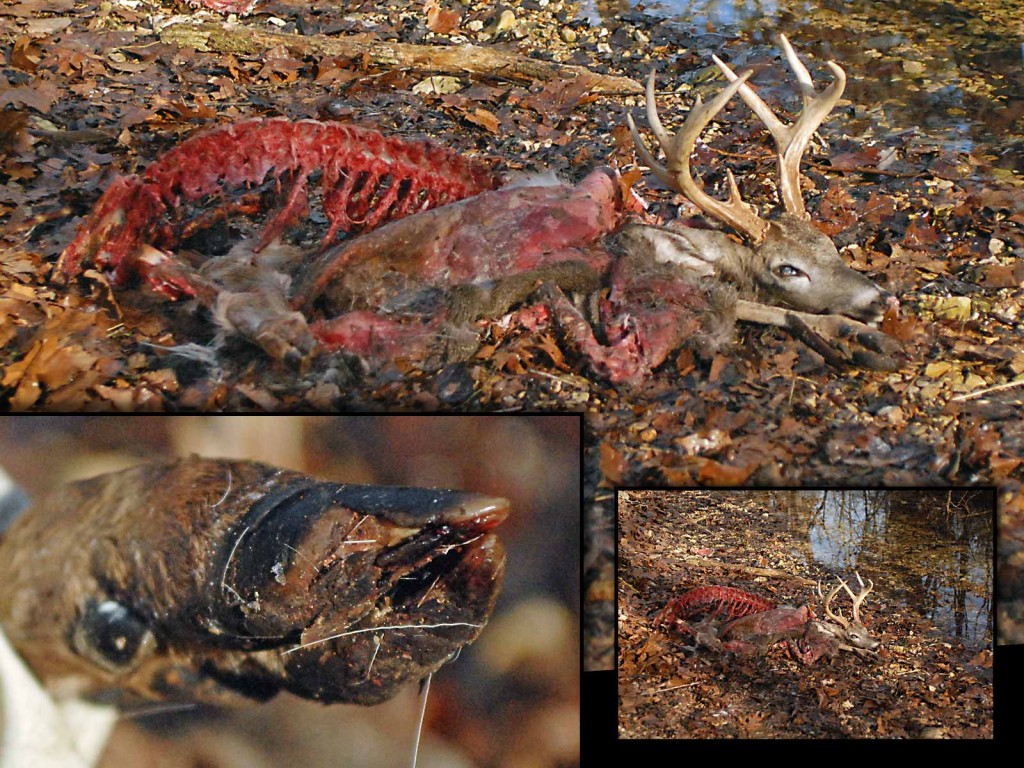
Initially I will walk the valleys in search of deer that may have died during the fall from EHD, like the buck pictured above.
On the brighter side, hunting in the valley has an additional benefit – it is relatively flat which will be the beginning of conditioning for both Crystal and me for the harder exercise of searching the hills!
Once the water sources have been hunted I will move on to the rest of the property. Grant and the boys will still be using the Reconyx cameras to monitor the deer herd to determine which bucks made it through the season. As soon as bucks start to show they are loosing antlers, I will develop specific areas to canvas based on the travel patterns shown by the Reconyx MapView software. Perhaps we’ll get lucky like we did last year (see it here in GDTV 116) and the Reconyx will capture images of one of our hit list bucks the night that he sheds his antlers!
Grant and I will be sharing some other tactics to help you find shed antlers in future blog posts. In the meantime – get out there to get some exercise and enjoy Creation! Enjoy the shed hunting season and share when and what you find on our Facebook page! I look forward to hearing about and seeing all the great treasures you find in the next few weeks.
Enjoying Deer together,
Tracy Woods
Why Bucks Are Shedding Antlers Early
Throughout the whitetails range I am receiving reports and photos of bucks that are already shedding their antlers. Since early December 2012 I’ve gotten several Reconyx trail camera pictures of bucks that have already shed one or both antlers here at The Proving Grounds. It’s common for an occasional buck to shed early due to injury. However, I suspect about 10%+ of the bucks at my place have already shed.
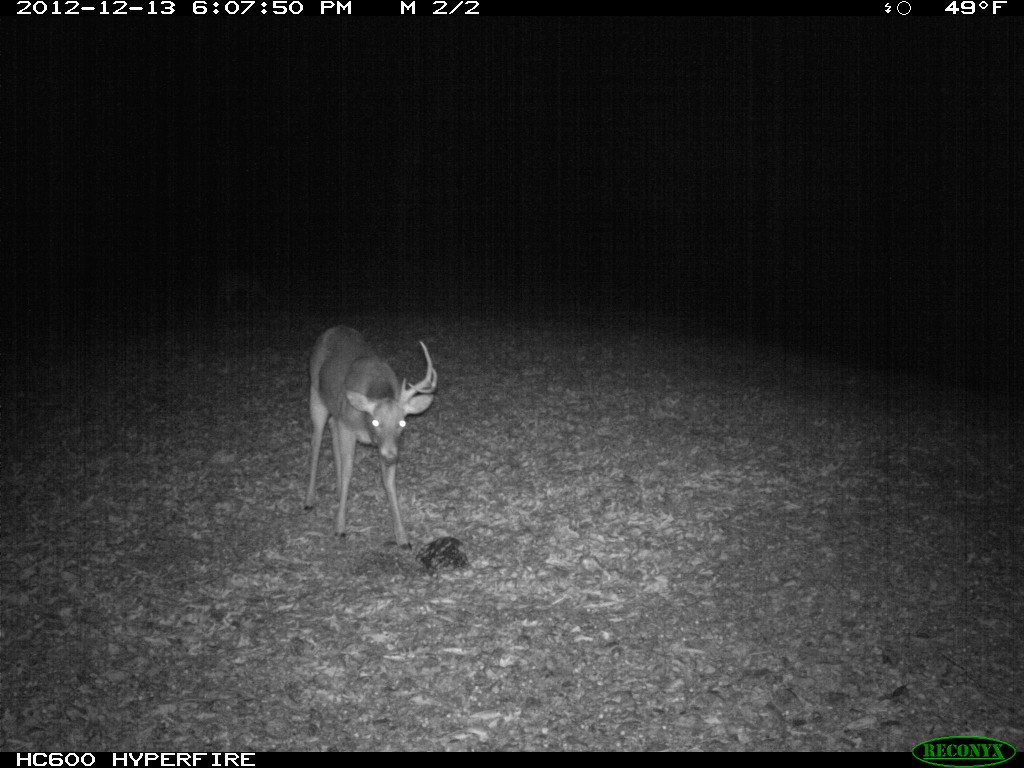
Since early December 2012 I’ve gotten several Reconyx pictures of bucks that have already shed one or both antlers.
Early shedding is a sign of stress. I’m sure deer at my place are stressed. During the 2011 growing season we experienced an extended drought followed by a record drought (the driest July during 118 years of record keeping) during 2012. Plants can’t transfer nutrients without water. Therefore forage quality was most likely severely decreased during the past two years.
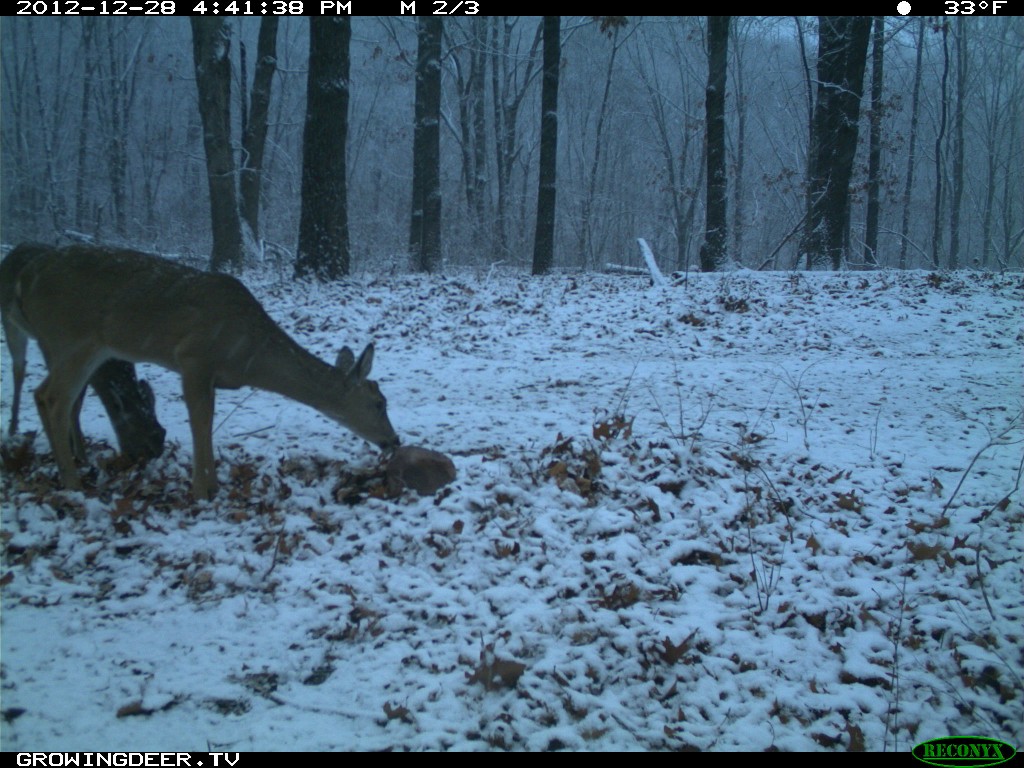
During the past two years the deer at my place experienced extended drought and a major outbreak of EHD.
There was also a major outbreak of EHD at my place (as in many places from Florida to Wyoming) last fall. There are two forms of EHD, acute and chronic. Deer with the acute form of EHD usually die within 24 to 36 hours. Deer with the chronic form may or may not die. If they do die, it often takes months.
We’ve found bucks that probably died from both forms of EHD (GDTV 147). The good news is that Mrs. Tracy will likely find a lot of sheds this year! The bad news is that she will also find a lot of skulls of bucks that died before they shed their antlers. I’ll keep you posted as Tracy and Crystal begin shed hunting. They will start just as soon as the archery season closes in Missouri (January 15, 2012).
I’ll begin a supplemental feeding program using the high quality feeds from Record Rack. I’ve never used supplemental feed before at The Proving Grounds. However, given the drought and amount of stress the herd is experiencing at my place, I think supplemental feeding is a very smart management strategy. I’ll keep you posted on our feeding program through this blog, on my Facebook page, and on GrowingDeer.tv!
If you’ve never used supplemental feed before, stay tuned and I’ll show you how and why I opted to use this strategy from a biologist’s point of view.
Growing Deer together,
Grant Woods, Ph.D.
Wildlife Biologist
Coyotes and Whitetails
Adam and Brian are in Kansas filming a late season bow hunt. Yesterday afternoon about prime time some does and young bucks were in the food plot Adam and Brian were watching as they eagerly waited for a mature buck to approach. Then several of the deer on one side of the field sprinted away with two coyotes in pursuit. Many hunters have shared this observation with me recently – seeing deer chased by coyotes.
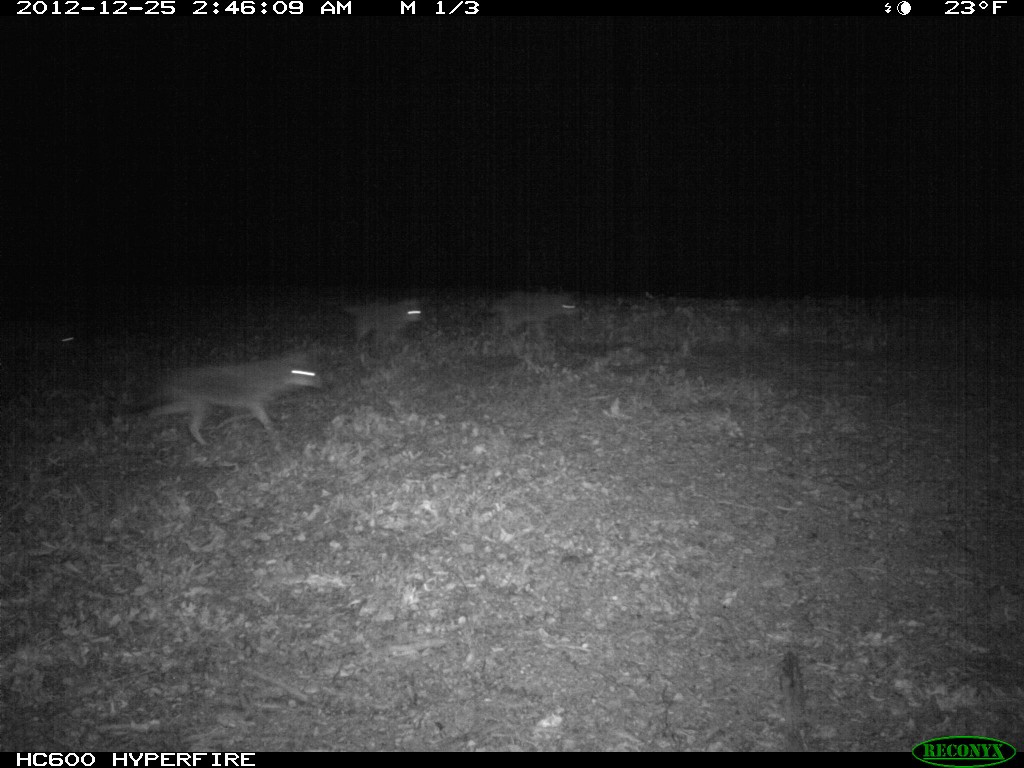
Many hunters have shared seeing deer chased by coyotes recently.
Several research projects during recent years has documented that coyotes are killing a significant portion of fawns in some areas. It’s also been documented that coyotes (and other predators) can cause significant stress or mortality to adult deer.
Even if this research hasn’t been repeated in the state where you hunt, you can look for signs of predator/prey populations being out of balance toward predator species. Do you often see adult deer being stalked or chased by coyotes? Do deer where you hunt act extremely wary or alert when a coyote howls? Do you get trail camera pictures of multiple coyotes together?
Coyotes weren’t considered to be pack hunters when I was in graduate school (many years ago). However, coyotes have been documented to have interbred with gray wolves in the northeastern states and Canadian provinces. Large “coyotes”, such as 80+ pounds, have been documented in states as far south as my home state of Missouri.
Genetic testing has shown that some of the large “coyotes” are actually wolf/coyote hybrids while others are dog/coyote hybrids. In both cases these hybrids are certainly capable of killing adult deer, and tend to hunt in packs more than pure coyotes.
Coyotes (and other predators) were hunted frequently when I was a child by farmers that were protecting their stock and by trappers that gained income by selling their pelts, glands, etc. However, the number of farmers, ranchers, and trappers has decreased substantially during the past 20 years.
The number of coyotes has increased significantly in many states as well as the average size of coyotes in some areas. It’s time for hunters to help bring back a healthy balance between predators and prey species in many areas. I’m loading up my Winchester ammo and FoxPro caller and going out to do my part.
Growing Deer together,
Grant
EHD Still Killing Bucks
I was checking traps this week and noticed a bunch of vultures coming from the ground. That’s never a good sign. As I peeped over the creek bank, I saw a very good two year old buck – dead and already consumed by scavengers/predators.
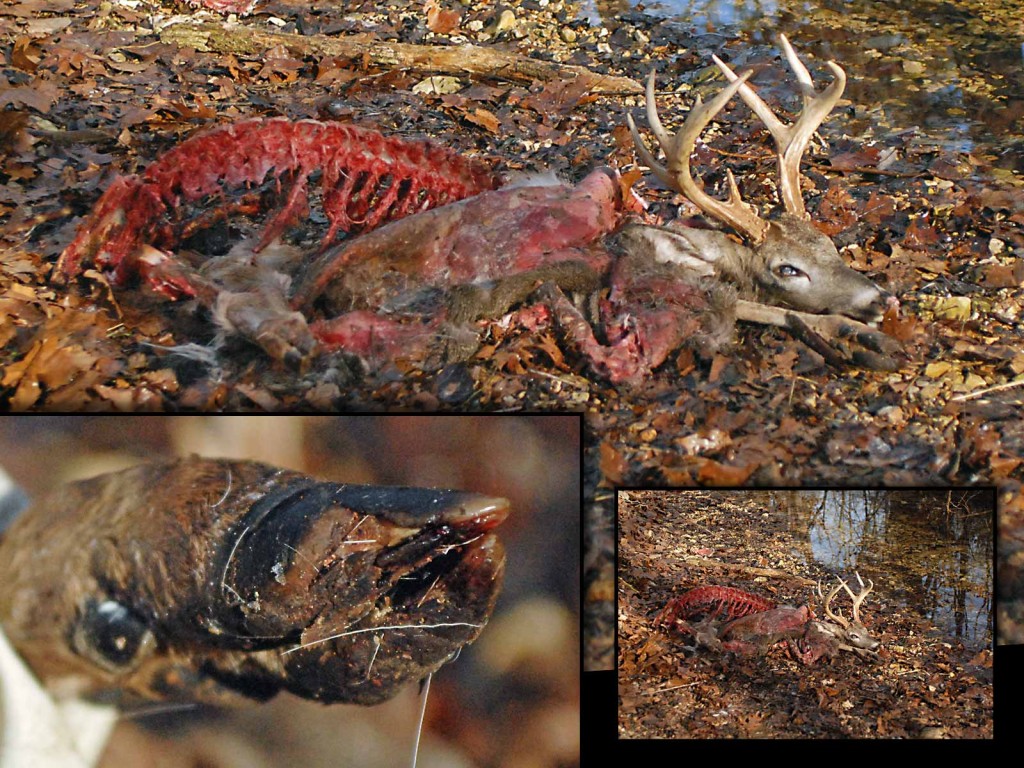
This two year old buck, found dead at The Proving Grounds, probably had the chronic form of EHD
A quick check confirmed my suspicions that the buck’s hooves were cracked and sloughed. This buck apparently had the chronic form of EHD (Epizootic Hemorrhagic Disease). If you are not familiar with EHD, check out this quick fact sheet.
The day I found this buck, Adam and Brian filmed a doe that was harvested by one of our friends at the Redneck Blinds Proving Grounds. She also had sloughed hooves – a survivor (so far) of the chronic form of EHD.
I’ve also had many friends calling from throughout the Midwest that have either found fresh dead deer or had trail camera images of bucks that have already shed their antlers.
Amazingly I read a report last week that EHD was over. That’s incorrect. Anything that stresses deer tends to have a long term impact. In addition, the chronic form of EHD is known to impact deer for months after a frost kills the biting flies that transmit the virus.
The death toll from this year’s outbreak of EHD isn’t over. Deer with the sloughed hooves will have a very hard time escaping predators this winter. As the cold weather makes predators (primarily coyotes) burn more calories and as the population of rodents and rabbits decreases, deer become more and more of a primary food base for coyotes. Deer, even mature bucks, with sloughed hooves due to EHD, have very little chance of surviving this time of year.
The increasing predator population, compared to years ago when fur prices were high enough to encourage trapping, will result in a higher late season death toll from EHD than I was taught in school. The only way to help these bucks is to remove as much stress as possible by making sure quality food is available and reducing the population of predators! That’s my plan.
Growing Deer together,
Grant
Why Bucks Shed Antlers Early
The rut is tough. It’s probably like playing professional football without pads! Certainly some players would get hurt. The same is true with deer. Some bucks get hurt (gored, kicked, etc.) during the rut.
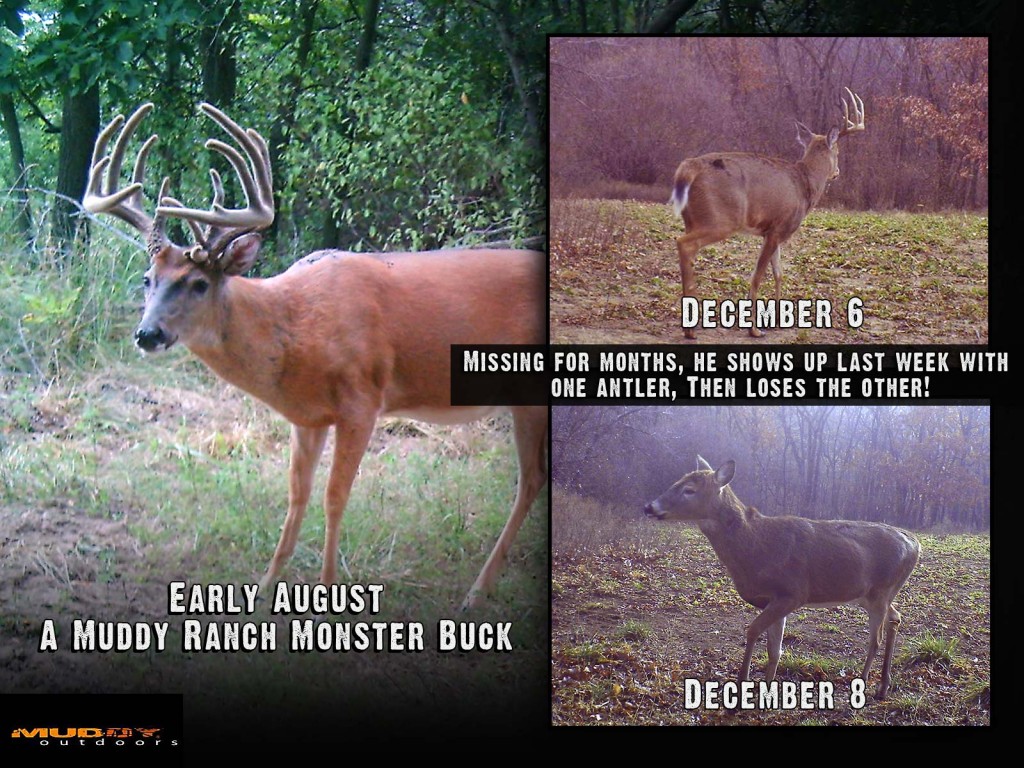
Muddy Ranch buck sheds early
Bucks shed their antlers when certain hormones, primarily testosterone, drop below minimum levels. A buck’s testosterone level can drop earlier than normal if he is injured or sick. A few bucks are injured every year during the rut so it’s common to hear of a buck or two that someone saw or got a trail camera pic of during early December that has already shed.
This year may be a bit different. The largest outbreak of hemorrhagic disease that’s been recorded in 55 years occurred. Record droughts occurred throughout much of the whitetail’s range resulting in decreased forage quality and production. In short, many deer herds experienced a LOT of stress during 2012.
I knew all of this, but wasn’t prepared for all the reports, trail camera pics, etc., I’ve already received from folks about bucks that have already shed! The subjects of my recent blogs were about why I like and the techniques I use to tag bucks during the late season!
I’ll still hunt until the end of season (January 15th at my place in Missouri). However, the number of hit list bucks that hold their antlers till then will be slim. The good news is that I can begin shed hunting January 16th!
Growing Deer together,
Grant
Changes In Hunting Strategy: Fawn Predation
As I explained in my blog last week, Hunting Strategies: The Late Rut, my primary buck hunting strategy this time of year is geared around fawns. Female fawns reach puberty when they’ve grown enough to weigh about 70 pounds throughout most of the whitetails range. That’s obtainable in most areas if there is adequate quality forage and a fairly balanced adult sex ratio. One of the many benefits of a balanced adult sex ratio is that there are plenty of bucks available to breed the does as soon as they become receptive.
These fawns often reach puberty during the later portion of deer season which causes a flurry of rutting behavior. In areas where the deer herd is “tuned up” (a balanced adult sex ratio, older age class bucks present, and ample quality forage to allow deer to express most of their body and antler size potential) female fawns typically reach puberty about a month or so after adult does. This flurry of rutting behavior is often called the “secondary rut.”
I live and hunt on an island of deer management. I’m only aware of one neighbor (out of 34) that establishes food plots (although the game wardens have made a few cases of folks hunting over bait), passes up immature bucks, or attempts to harvest as many does as bucks. I’m truly an island in a sea of properties that simply shoot deer – primarily young bucks.
Even though my property is a deer management island, I’ve been able to improve the habitat enough that a substantial percentage of female fawns in my area reach puberty and bred during their first winter (there’s hope for all you “island” deer managers)!
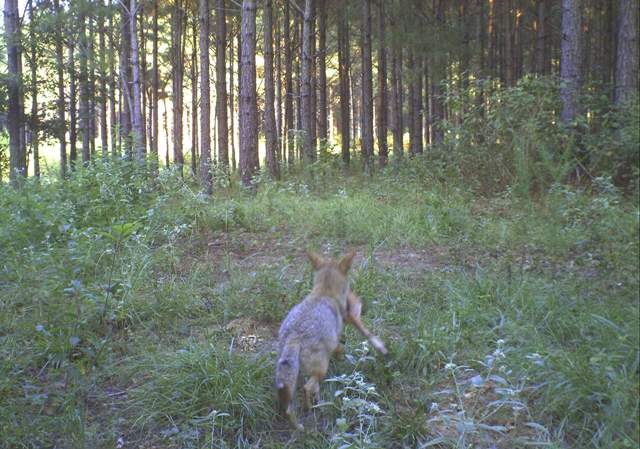
Coyotes are tremendous fawn killers, 60%+ of all fawns born in an area are killed primarily by coyotes.
However, if there aren’t many female fawns, this exciting hunting opportunity won’t happen (as well as several other negative impacts to the deer herd). That’s one reason I trap and hunt coyotes. Coyotes are tremendous fawn killers. They tend to kill fawns during the first few hours and weeks after the fawns are born. Amazingly, several university research projects have shown 60%+ of all fawns born in an area are killed by predators, primarily coyotes in most studies. This has huge impacts on the herd.Once you’ve digested that information, realize that the number of coyotes is rapidly increasing in many areas, especially in eastern states! At 60% +/- fawn mortality, there won’t be many fawns reaching puberty the following fall and therefore the fawn/food source hunting strategy won’t work. Actually, after a few years of heavy fawn mortality no deer hunting strategy will work well because there won’t be many deer!
That’s why I trap and hunt coyotes! Just as good stewards work to balance adult sex ratios and provide ample quality forage, they should also work to balance the predator/prey relationship so neither get out of balance and do long-term damage to the habitat or other species of wildlife. In many areas, removing predators benefits the deer herd and deer hunters as much as other deer management activities.
I’m out to check my traps now, and I’m spending most afternoons watching food plots and enjoying seeing fawns! I’m very confident one of them will have a mature buck following.
GrowingDeer together,
Grant
Hunting Strategies: The Late Rut
This time of year I always hear a lot of talk about the “late rut.” It’s often used in discussions about hunting strategies and stand placement.
Throughout most of the whitetail’s range, most does become receptive during early November. This is based on literally 10’s of 1,000’s of fetuses removed from harvested does and aged to determine their conception dates. With years of these data it’s clear that moon phase, weather, etc., doesn’t impact when deer breed. The only significant change in breeding dates for specific herds/properties that I’ve documented (or heard about) were caused by hunters purposely altering the herd’s adult sex ratio. They changed the herd’s adult sex ratio by harvesting more does and passing young bucks on properties where the deer harvest had been predominately bucks for years. I’ve documented a shift in the average breeding date of more than 30 days as a response to a few years of working to balance the adult sex ratio. As a result of these efforts the hunting also improved substantially as more mature bucks were competing for does. The bucks responded to rattling, grunt calls, decoys, etc.
The more balanced the adult sex ratio, the shorter and more intense the rut will be. For example, if the deer harvest in an area where you hunt has been close to being balanced (as many does as bucks) for a few years, then expect a few does to become receptive early, a flurry of breeding activity, and then the breeding activity tapering off. Imagine a bell-shaped curve of breeding activity. The right side of the bell is usually a gentler slope (the breeding activity may tapper off slower than it started) than the left side.
Female fawns usually reach puberty and become receptive if they reach 60-70 pounds during their first fall/early winter. In soybean and corn production regions, areas with high quality native habitat, properties with a substantial amount of quality food plots, etc., many female fawns will become receptive. Depending on the quality of the habitat, this can vary from a very small percentage of the female fawns (usually in areas where timber is the primary land use) to 80+% in areas of Iowa.
In areas where a high percentage of female fawns do reach puberty during their first fall, the amount of bucks seen cruising, chasing, etc., certainly appears like a second rut! This is simply one more reason to manage for a balanced adult sex ratio and high quality habitat. This work not only will allow bucks to produce larger antlers, but create better hunting throughout a longer period of time!
Simply stated, the intensity of the” late rut” is strongly related to health of the female fawns in that area. The health of female fawns is determined by the herd and habitat quality. You can enjoy an action packed late rut by either hunting in agricultural production areas or working to improve the herd and habitat quality where you hunt.
I live on an island of quality deer habitat – literally. I live and hunt where timber and fescue (same as a biological desert) are the primary land use. I’ve worked to improve the habitat and have created quality hunting in a white-tailed deer habitat desert. You can enjoy the “late rut” anywhere, even if you hunt on an island like me. However, those of us that hunt on an island must work a bit harder to enjoy the same quality of hunting as those that hunt in corn and soybean production areas!
Growing Deer together,
Grant
How to Hunt this Week
By today, November 23rd, most does have been bred where I live in southern Missouri – and throughout most of the whitetail’s range. There are exceptions including parts of Alabama, south Texas, etc. How can I say that confidently?
Each year throughout the whitetails’ range most fawns are born before June 15th (except in parts of Alabama, south Texas, etc.). The gestation period for white-tailed deer is approximately 200 days. Therefore does bred on or before November 23rd would be born on or before June 11th. Most fawns are born during mid-May to early June.
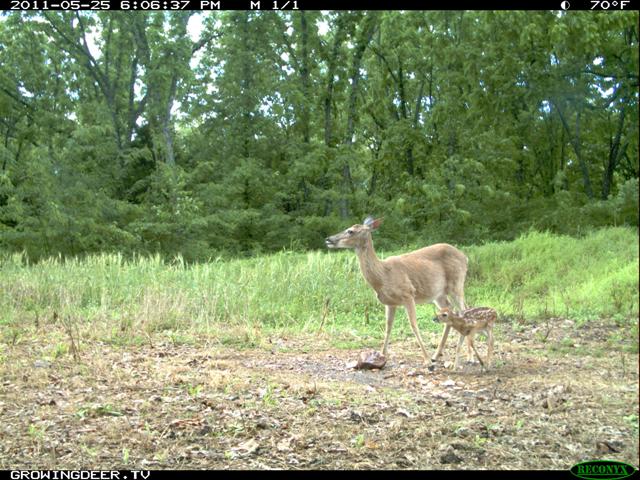
This picture was taken May 25th and the fawn is probably a week or less old. Not many fawns are seen traveling with does at this time of year at my farm.
Fawns are usually two to three weeks old when they begin actively following does. It’s certainly possible to see a doe moving a fawn (encouraging it along) before the fawn is two weeks old, but when you begin seeing fawns in multiple places you can be confident they are at least two to three weeks old.
A great tip is to pay attention to when you see fawns or begin noticing fawns on trail cameras and then subtract 190 days and estimate when the peak of breeding occurred (and will occur again) in that area.
I’d much rather hunt a week or so before than after the peak of breeding! When the majority of does are receptive, bucks don’t have to move far to find a doe and begin tending her. Bucks will move the least amount possible while tending a doe. More movement simply means another buck is likely to attempt to cut in on the action.
I like hunting before the peak of breeding more than the week after the peak of breeding. There are two reasons for this statement. First, there will likely be more bucks available to hunt during the pre-rut. Some bucks will be killed by hunters, injured or killed while fighting, etc., during the peak of breeding. There will simply be fewer bucks available to hunt after the peak of breeding. Second, the level of activity/movement seems higher before the peak of breeding compared to after the peak. The party is just starting and everyone wants in on the action!
Paying attention to when you and your friends begin seeing fawns next summer can be a great clue to when you should schedule time to hunt next fall!
Growing Deer together,
Grant



